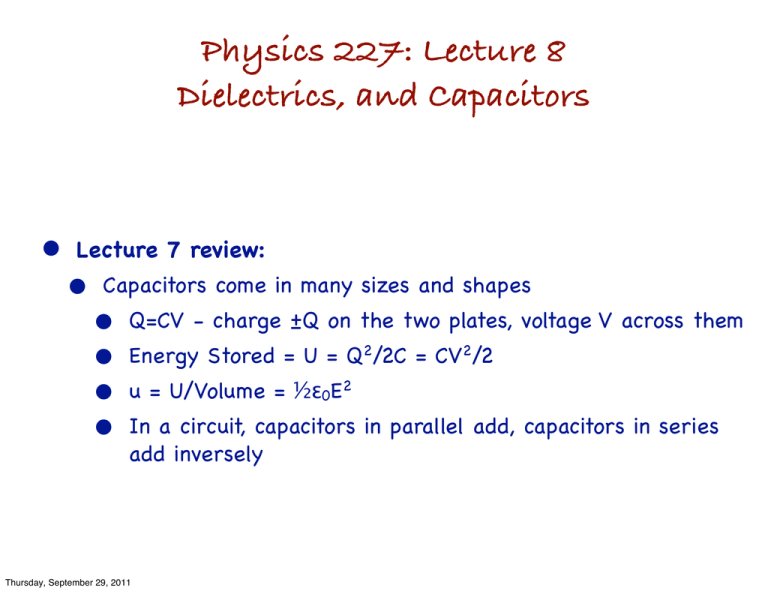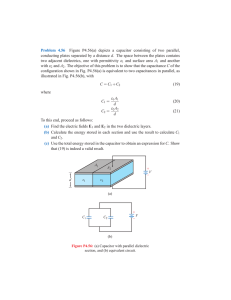Physics 227: Lecture 8 Dielectrics, and Capacitors
advertisement

Physics 227: Lecture 8 Dielectrics, and Capacitors • Lecture 7 review: • Capacitors come in many sizes and shapes • • • • Q=CV - charge ±Q on the two plates, voltage V across them Energy Stored = U = Q2/2C = CV2/2 u = U/Volume = ½ε0E2 In a circuit, capacitors in parallel add, capacitors in series add inversely Thursday, September 29, 2011 Capacitive Iclicker Puzzle Student A says: The plates of my parallel plate capacitor attract each other, so I have to hold them to keep them apart. Student B says: The plates of my capacitor repel each other, so I have to hold them to keep them together. Who is right? A. A. B. B. C. Both A and B. D. Neither. E. This does not make sense. Thursday, September 29, 2011 Remember your answer to this brain teaser. We will find out the right answer in the next few slides. Capacitive Iclicker Puzzle Student A says: The plates of my parallel plate capacitor attract each other, so I have to hold them to keep them apart. Student B says: The plates of my capacitor repel each other, so I have to hold them to keep them together. Who is right? A. A. B. B. C. Both A and B. D. Neither. E. This does not make sense. Thursday, September 29, 2011 Remember your answer to this brain teaser. We will find out the right answer in the next few slides. Changing Capacitance • • A parallel plate capacitor has Q = CV with capacitance C = ε0A/d. • It is natural to think that, since the plates have opposite charge, the forces between them are attractive. Student A is right!? • How can we change the capacitance? The easy way is to move the plates closer together or farther apart. Let’s look in more detail at what happens when the plates come closer together ... • • • Since Q is the same, the electric field is constant, so the energy density u = ½ε0E2 is constant. Constant u with decreasing volume → less stored potential energy, so U is being converted into kinetic energy of the plates. It all makes sense, student A was right! The force is attractive, the plates would naturally come together, they have to be held apart. Thursday, September 29, 2011 Changing Capacitance - Not so fast • • A parallel plate capacitor has Q = CV with capacitance C = ε0A/d. • • What if the capacitor is in a circuit? Do we get the same answer? We made an assumption: ``Since Q is the same...’’ We assumed the capacitor is not connected to a circuit and the charge is constant. Now the voltage V is fixed. When we move the capacitor plates, V stays the same. • • Since V = Ed, if we push the plate together, the distance decreases, so a larger field is needed. If we pull the plates apart, a smaller field is needed. Let’s change the distance between the plates a factor of 2. The field changes a factor of 2, the opposite way, to keep the voltage fixed. What happens to the energy? Thursday, September 29, 2011 Changing Capacitance - Not so fast • • • A parallel plate capacitor has Q = CV with capacitance C = ε0A/d. • • Increasing d by a factor of 2 decreases C and U by a factor of 2. • • • What happens to the energy? With the voltage V fixed, and U = ½CV2, the energy stored is proportional to C. The force between the plates is in the direction to reduce the potential energy, so the force would increase d - it is repulsive! Does this make sense considering the energy stored in the electric field? With constant V and d bigger by a factor of 2, V = Ed tells us that the field E and the charge Q decrease by a factor of 2. The energy density u = ½ε0E2 decreases a factor of 4, the volume Ad increases a factor of 2, so the stored energy is 2 times less, agreeing with the result above Student B is right! Thursday, September 29, 2011 Summary • • A parallel plate capacitor has Q = CV with capacitance C = ε0A/d. • Student B has a capacitor (in a circuit) with a fixed voltage V, and finds the force between the plates is repulsive. • Student A has a capacitor with a fixed charge Q, and finds the force between the plates is attractive. They are both right. The physical situations are different, though they seem the same when crudely described. Thursday, September 29, 2011 Dielectrics in Capacitors • Capacitance of capacitors is increased by putting a dielectric material in between the conductor plates. • • • It also allows a higher voltage across the capacitor than vacuum, and provides mechanical support. How does this work? When you put a material in an electric field, it can become polarized... Thursday, September 29, 2011 Dielectrics • This leads to a surface charge density on the dielectric that reduces the electric field inside the dielectric to be smaller than the applied field. Thursday, September 29, 2011 Voltage on a Capacitor filled with a Dielectric • • When you fill the volume of a capacitor with a dielectric, the electric field decreases, so the voltage across the capacitor decreases - for fixed charge. Since Q = CV = constant, V decreasing requires that C increases. Thursday, September 29, 2011 • • • Dielectric Constant We can define the dielectric constant as the ratio of the capacitance of a capacitor with a dielectric to the capacitance with vacuum between the plates: K = C / C0. So C0 = ε0A/d → C = Kε0A/d. For constant charge Q, E = E0/K, V = V0/K Table from textbook, page 801 Thursday, September 29, 2011 Dielectric iClicker • • • We can define the dielectric constant as the ratio of the capacitance of a capacitor with a dielectric to the capacitance with vacuum between the plates: K = C / C0. So C0 = ε0A/d → C = Kε0A/d. For constant charge Q, E = E0/K, V = V0/K By what factor does the stored potential energy change, for constant charge Q? U/U0 = ? A. same - 1. B. bigger by K C. smaller by K. D. bigger by K2. E. smaller by K2. Thursday, September 29, 2011 Dielectric iClicker • • • We can define the dielectric constant as the ratio of the capacitance of a capacitor with a dielectric to the capacitance with vacuum between the plates: K = C / C0. So C0 = ε0A/d → C = Kε0A/d. For constant charge Q, E = E0/K, V = V0/K By what factor does the stored potential energy change, for constant charge Q? U/U0 = ? Three ways to get the same answer: U’ = C’V’2/2 = KC(V/K)2/2 = CV2/2K = U/K U’ = Q’2/2C’ = Q2/2KC = U/K u’ = εE’2/2 = Kε0(E/K)2/2 = ε0E2/2K = u/K Thursday, September 29, 2011 A. same - 1. B. bigger by K C. smaller by K. D. bigger by K2. E. smaller by K2. Splitting a Capacitor into Two d • • • • • • + Area A + + + + + + + +Q - - - - -Q d + Area A/2 + + + +Q/2 - - -Q/2 + Area A/2 + + + +Q/2 - - -Q/2 Cut in the middle separate the two halves. A parallel plate capacitor has Q = CV with capacitance C = ε0A/d. There is the same electric field in all the capacitors. There is the same voltage across all the capacitors. The charge on the left capacitor is the sum of the charges on the right two. The energy stored in the left capacitor is CV2/2. Each capacitor on the right has half as much energy, since C is half as large. This is what we expect from adding capacitors in parallel. Thursday, September 29, 2011 Now consider Inserting a Dielectric Into a Capacitor What is the force on the dielectric? • There is constant voltage across the capacitor. To figure this out, we are going to divide the capacitor into two halves, a half with dielectric between the plates and a half with vacuum between the plates. Thursday, September 29, 2011 Splitting a Capacitor into Two dielectric constant K d + Area A/2 + + + +Q/2 - - -Q/2 + Area A/2 + + + +Q/2 - - dielectric constant 1 -Q/2 • • A parallel plate capacitor has Q = CV with capacitance C = ε0A/d. • Left side: Voltage V, field V/d, energy stored ½CV2 = ½(Kε0A/2d)V2 = ¼Kε0AV2/d. But: charge density σ = ε0V/d comes from the charge on the capacitor plate plus the surface charge of the dielectric. Since the field is reduced a factor of K, σcapacitor increases a factor of K to keep V constant. Thus, σcapacitor = K ε0V/d and Q = Kε0AV/2d. • Right side: Voltage V, field V/d, energy stored ½CV2 = ½(ε0A/2d)V2 = ¼ε0AV2/d. Also: charge density σ = ε0V/d, charge Q = ε0AV/2d, The battery supplies charge to keep the voltage constant. Thursday, September 29, 2011 Inserting a Dielectric Into a Capacitor in a Circuit • What happens if there is constant voltage across the capacitor? What is the force on the dielectric? What would happen if it could move freely? A. It is pulled in to the capacitor. B. It is pushed out of the capacitor. C. There is no force on the dielectric. D. There is no sideways force, there is a vertical force. E. Uh ... Thursday, September 29, 2011 Inserting a Dielectric Into a Capacitor in a Circuit • What happens if there is constant voltage across the capacitor? What is the force on the dielectric? What would happen if it could move freely? Forces push ``downhill’’, A. It is pulled in to the capacitor. towards smaller B. It is pushed out of the capacitor. potential energy. For constant V capacitor, C. There is no force on the dielectric. that is without the dielectric. (For constant D. There is no sideways force, there is a vertical force. Q, it is with the E. Uh ... dielectric.) Thursday, September 29, 2011 Thank you. Prof. Gilman will be back Monday Oct. 3. Exam 1 is 9:40 PM Thursday Oct. 6. There will be optional review sessions instead of lectures. You are allowed one formula sheet. Anyone with conflicts or needing special arrangments should contact Prof. Cizewski ASAP. Thursday, September 29, 2011



